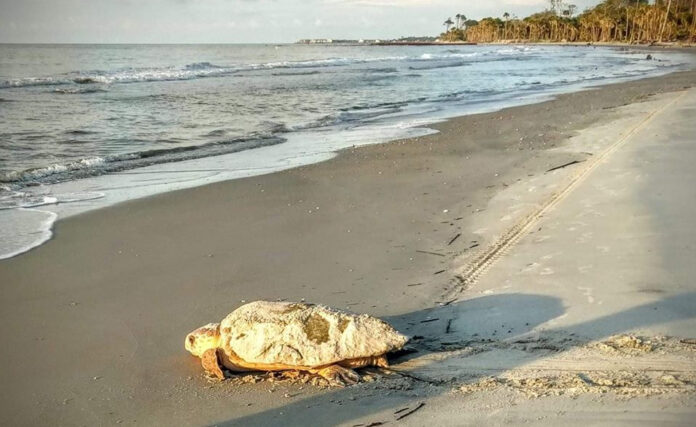The numbers are in, and the official 2022 South Carolina sea turtle nesting season concluded October 31st with welcome news. Data collected by SCDNR staff and its volunteer network showed an estimated 8,004 nests laid along state beaches this year, the second-highest number on record.
“We’re excited to see another successful nesting year for sea turtles along the South Carolina coast,” said Michelle Pate, nesting program leader for the S.C. Department of Natural Resources.
“Increased nest counts since the mid to late 2000s show promise for the loggerhead; we’re seeing the continued benefits of conservation measures enacted decades ago as well as those management techniques still used today.”
Most nests in South Carolina belong to loggerhead sea turtles, which accounted for over 99% of nests in 2022. But loggerheads weren’t the only species to visit the coast this year. Green sea turtles laid an estimated 21 nests on beaches ranging from Myrtle Beach to Edisto Island, a record number for South Carolina. The threatened green sea turtle is an infrequent nester on state beaches, but young greens are more common in South Carolina salt marshes and tidal creeks, where they find shelter and food.
Locally in Beaufort County, the numbers were fantastic.
Hunting Island has set a new record with a total of 175 nests. Harbor Island had 97 nests while Fripp Island had 82, which is lower than usual for Fripp. Other local nesting spots are Pritchards Island with 125 nests, Little Capers Island with 118. Edisto’s beaches have found a whopping 1,101 sea turtle nests combined on all four spots.
Even little Coffin Point Beach on St Helena Island had 20 nests and the beach at Lands End on St. Helena Island had 3.
In the southern end of Beaufort County, Hilton Head’s beaches have seen 423 nests and there have been 95 found on Daufuskie Island this year.
In late September, beaches north of Charleston took a powerful beating from Hurricane Ian – including the state’s densest nesting islands in Cape Romain National Wildlife Refuge. The Category 1 storm made landfall south of Georgetown.
“Fortunately, most of the nests had already hatched by the time the storm reached us,” said Pate. “But continued and heavy overwash by King Tides [seasonally high tides] earlier in the season rendered a lot of eggs non-viable.” Collectively, King Tides and Hurricane Ian reduced the nesting habitat available to nesting females by eroding beaches, including recently renourished beaches.
A success story of the season unfolded in the Town of Edisto Beach, where work to reduce the dangers of artificial lighting continued to pay off. Sea turtles rely on the light of the night horizon to navigate, making both nesting mothers and emerging hatchlings very sensitive to artificial lights.
Repeated instances of sea turtle disorientation due to nearby street and beachfront lighting led the Town of Edisto Beach to secure a federal grant in 2020 to install new, turtle-friendly streetlights. With the help of Dominion energy, the lights were installed in 2021, and instances of hatchling disorientation dropped this year. Beachfront lighting continues to be a persistent problem elsewhere, particularly on the heavily visited, heavily lit beaches of Hilton Head Island and the Grand Strand.
South Carolina’s federal recovery goal for loggerheads is 9,200 nests. Nest numbers are just one of many considerations and milestones that are part of the national Recovery Plan for the loggerhead sea turtle, but they’re part of a growing body of research suggesting the species is on a positive path.
This is also a testament to the well trained volunteers who patrol the beaches every day from May through October performing a variety of tasks. They report the nests, the help protect them and they even move them if the momma turtle was having a bad night and picked a bad spot for her nest.
Kudos to these folks, and we extend a big “thank you” to their tireless efforts.










